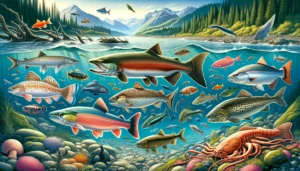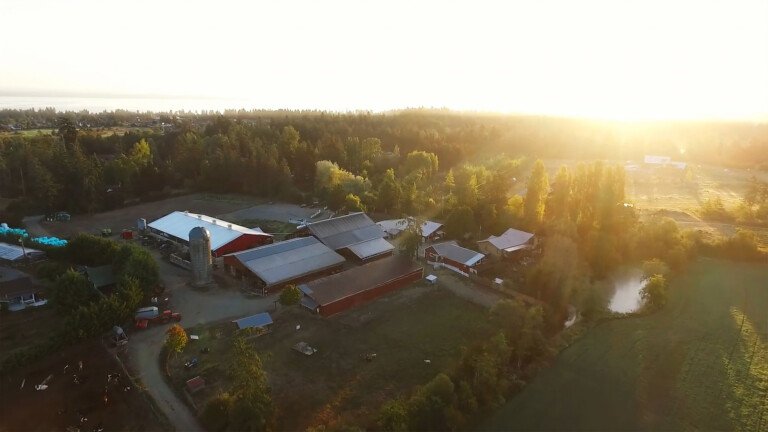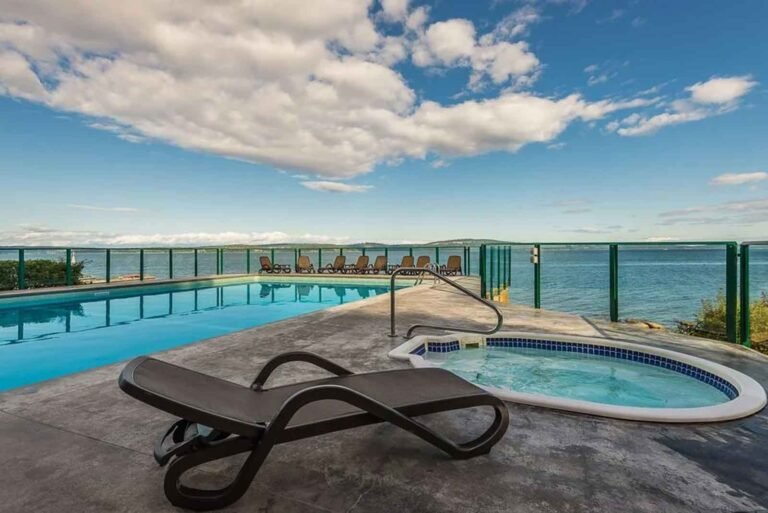Fish Species in British Columbia
Whenever anglers get together to discuss saltwater fishing, British Columbia and salmon are synonymous – and for good reason!
Located along its rugged coastline are several major feeding grounds used year-round by chinook and coho salmon, which provide excellent recreational fishing. In addition, several million Pacific Salmon appear along the coastline each year, most on spawning migrations to their rivers of birth in British Columbia, others travelling farther south.
Salmon have always been vital to life in the Pacific Northwest and are part of a heritage Canada shares with the United States. There are 5 species of salmon indigenous to the coastal waters of British Columbia; chinook, coho, sockeye, pink and chum salmon.
Away from the ocean, anglers catch nearly nine million fish in BC’s freshwater rivers, lakes and streams, which produce an amazing abundance and variety of freshwater fish.
The prime attraction for most anglers is the Rainbow Trout, a species well distributed throughout the province. Steelhead Trout, famous for their size, strength, speed and stamina, are present in most coastal and island rivers draining into the Pacific Ocean.
Coastal Cutthroat Trout are native to most lakes and rivers along the coastal mainland and offshore islands. Three species of Char are also native to British Columbia.
Introduced species of Brown Trout reach double digit weights in the Cowichan and Little Qualicum watersheds on Vancouver Island, as do healthy populations of Smallmouth Bass.
Needless to say, the fish descriptions we provide here only reflect a small percentage of the fish species found in British Columbia. More descriptions will be added as the website develops.
Pacific Salmon
Chinook Salmon (King, Spring, Tyee)
The Patriarch of the Salmon family, largest of all the species, they also live the longest. This Pacific Salmon averages 33 to 38 inches in length and weighs about 30 lbs.
With a life cycle of 3 to 7 years, these salmon remain out in the ocean longer than any other species, accounting for their dominant size. Off Vancouver Island, 40 and 50 pounders are not uncommon.
Year-round angling sees the larger catches in Summer/Fall, while Winter/Spring gives great angling for dinner-size winter springs. Ocean and river angling can prove to be tackle busting if not properly equipped. Sheer brute strength and powerful long runs, when hooked, describe the fighting qualities of these magnificent salmon.
Coho Salmon (Silver, Blueback)
They are the most popular game fish of the salmon family, as well as being one of the most valuable commercial species. The coho is usually 20 to 26 inches in length and 8 to 12 lbs in weight, with a 3 to 5 year life cycle.
Coho have the reputation, pound for pound, of being by far the best fighting salmon. Around Vancouver Island, 20 pound Coho can seem to be the norm in the Fall months.
Available through most of the summer, their size increases till late Fall spawning. The ocean, estuaries and rivers are great places to hook these aggressive salmon. Troll bucktail flies in the ocean and flyfish estuaries and rivers for these awesome fighters. Acrobatic leaps, tail-walks and screaming reels account for the popularity of these fighting fish.
Sockeye Salmon (Red, Kokanee)
The sockeye is rated as the best eating salmon by virtue of its delectable taste. There are saltwater (Sockeye ) and freshwater (Kokanee, lake-locked) species. They are very similar in appearance, except that the saltwater sockeye attains a larger length and weight.
A plankton feeder, the Sockeye Salmon can reach weights of over 10 lbs, and are usually about 20 to 24 inches in length. The flesh is often blood-red, with a high oil content and a great flavour.
You can intercept these very streamlined salmon in the summer months in the ocean and rivers of BC. Sockeye are generally known to be hard to catch, but when hooked on light tackle, they are strong determined fighters.
Pink Salmon (Humpback, Humpie)
The most prolific of the salmon family, a pink reaches 20 to 26 inches in length and averages 3 to 6 lbs in weight . Although they are the smallest of the Pacific Salmon, they can attain weights of over 10 lbs.
A two-year life cycle makes every other year a “pink year”, as the pinks return to their spawning river after only a couple of years plankton feeding in the ocean, unlike other species of salmon which mature after 3 to 5 years at sea.
The male pink develops a prominent hump between the head and dorsal fin when returning to their river spawning grounds, hence the name “humpie”. This summer angling fish is easy to catch and is a great introduction to fishing for children and novices. If you’re angling on a “pink year”, you’re almost guaranteed to catch your legal limit of Pink Salmon.
Chum Salmon (Dog, Keta)
A very underrated salmon, with great fighting ability and a growing popularity. A mature chum is about 26 inches in length and averages 10 lbs in weight. There are lots of larger fish in the 20 to 30 lb range. Another two year life cycle salmon, and also a plankton feeder.
Prior to spawning, the appearance of the males is shocking, as their lower jaw protrudes to display a sharp set of teeth, hence the name “dog salmon” (or keta, the Russian word for dog).
Chums are most distinguishable by the large and distinct dark purple vertical bars along their sides when close to spawning. A strong, scrappy salmon that’s very aggressive in freshwater, making them a great fly fishing challenge in our rivers.
Trout
Steelhead Trout (Coast Rainbow, Sliver Trout)
This legendary hard fighting fish is rated as one of the top sport fish in North America. It’s very similar to the rainbow that inhabits fresh water, the only major difference being that the larger steelhead is a seagoing fish.
Steelhead average 22 to 32 inches and weigh 8 to 10 lbs, but have been known to reach over 30 lbs. Lots of high teens to over 20 lb Steelhead inhabit our Vancouver Island rivers.
Some streams host two runs of steelhead, a summer run (returning in summer and early fall and spawning in midwinter or early spring) and a winter run (returning in early winter to late spring and spawning anywhere in this time frame).
These Summer and Winter Steelhead runs make our rivers fishable year-round. The Winter Steelhead are larger and demand that the angler brave what can be harsh elements to reach his goal.
Steelhead do not always die after spawning and some are able to spawn two to four times during their lifetimes. Generally, steelhead live for about 6 to 8 years. Returning Steelhead fresh out of the ocean carry a blue-black spotted back with silver sides and an alabaster belly (we refer to these fish as “Chromers”). Fish that spend time in a river return to the traditional colours of a rainbow trout.
With hundreds of steelhead rivers on Vancouver Island, you have a great opportunity to hook into these legendary fish while fly or gear fishing.
Rainbow Trout (Kamloops Trout)
An exciting fish to catch, and always willing to put up a good fight. These lake and river fish are smaller than steelhead, with an average length of 14 to 20 inches. Rainbow are known worldwide for their bold red stripe that runs down their body, which is usually darker in river fish than in lake dwellers.
Rainbows are aggressive fish that can be caught easily with fly and gear angling. The lower half of Vancouver Island has an adundance of rainbows in its rivers and lakes.
A great fish to angle for those family outings and for the serious anglers.
Brown Trout (German, European Trout)
A beautiful trout that is known as being wary, elusive and difficult to catch. Not so, if you learn about the behaviour of this smart, introduced species of trout. The average length of the Brown Trout is 16 to 18 inches with plenty in the 20 plus inch range, and on our world-famous Cowichan River, browns up to 10 lbs have been caught.
These light brown coloured trout have pronounced black spots on their backs and rusty red spots on their sides. A dozen lakes and rivers hold these cunning trout on Vancouver Island.
A fly fishing challenge that is worth the effort, but they can be caught on gear as well. Try your luck at outsmarting our Vancouver Island Brown Trout!
Cutthroat Trout (Coastal, Sea Trout)
Two red/orange slashes under the lower jaw mark this hard fighting rout. On Vancouver Island we have native cutthroat in our estuaries, rivers and lakes. Average length is 14 to 18 inches, but many of our ocean and lake Cutthroat reach 4 to 6 lbs.
Spread out over the whole Island, these eager eaters will snap at just about anything offered. The upper half of the Island does well for ‘Cutts’. Cutthroat Trout numbers are great, so throw a Fly, or gear fish year-round in our rivers and lakes for these scrappy trout.
Halibut – Pacific Halibut, Sea Flounders
Halibut are the largest of all the flatfishes, being found on or near the ocean bottom, over mud, sand or gravel banks.
While halibut have been recorded at depths of 3,600 feet, most halibut are caught at depths of 90 to 600 feet.
Although halibut can live to be up to 40 years old, grow to over eight feet long and weigh over 500 pounds, most halibut caught in the sport fishery will be 8 to 15 years old and weigh between 10 and 100 pounds.
Although the sizes quoted might seem to stretch the truth a bit, bear in mind that any halibut below 40 pounds is considered to be a “chicken”. The 206-lb halibut pictured to the right was caught on light salmon gear off the Sooke Bluffs by a surprised Jay Arsenault and Earl Harrison.
Female halibut live longer and grow faster and larger than do males. Few males exceed 80 pounds and, generally, all halibut over 100 pounds are females.
This mighty fish with incredible power gives the sport angler an exhilarating tug-of-war battle and puts up a strong fight.
The halibut is considered to be one of the most delicious table fish indigenous to the coastline of British Columbia. Enjoy unique angling for these “Barn Doors” from Spring to late Fall.
Bass – Smallmouth Bass: Black, Brown & Green Bass
The Smallmouth Bass is a robust fish that some consider to be the “best pound for pound fighter” around. Averaging from 8 to 16 inches long, these extremely aggressive fish put up a great battle when hooked.
It’s very common on Vancouver island to catch Smallmouth Bass in the 3 to 5 lb range, and even larger. The lower half of the Island, as well as Saltspring Island, have many trophy lakes for “Smallies”.
An awesome fish to catch on a family fishing outing or for any angler looking for non-stop action. Vancouver Island offers year-round lake fishing for bass, providing really enjoyable summer outings.
https://www.pac.dfo-mpo.gc.ca/fm-gp/species-especes/salmon-saumon/index-eng.html







